Chameleon vs Apty – Which Is Better for Interactive User Guides?
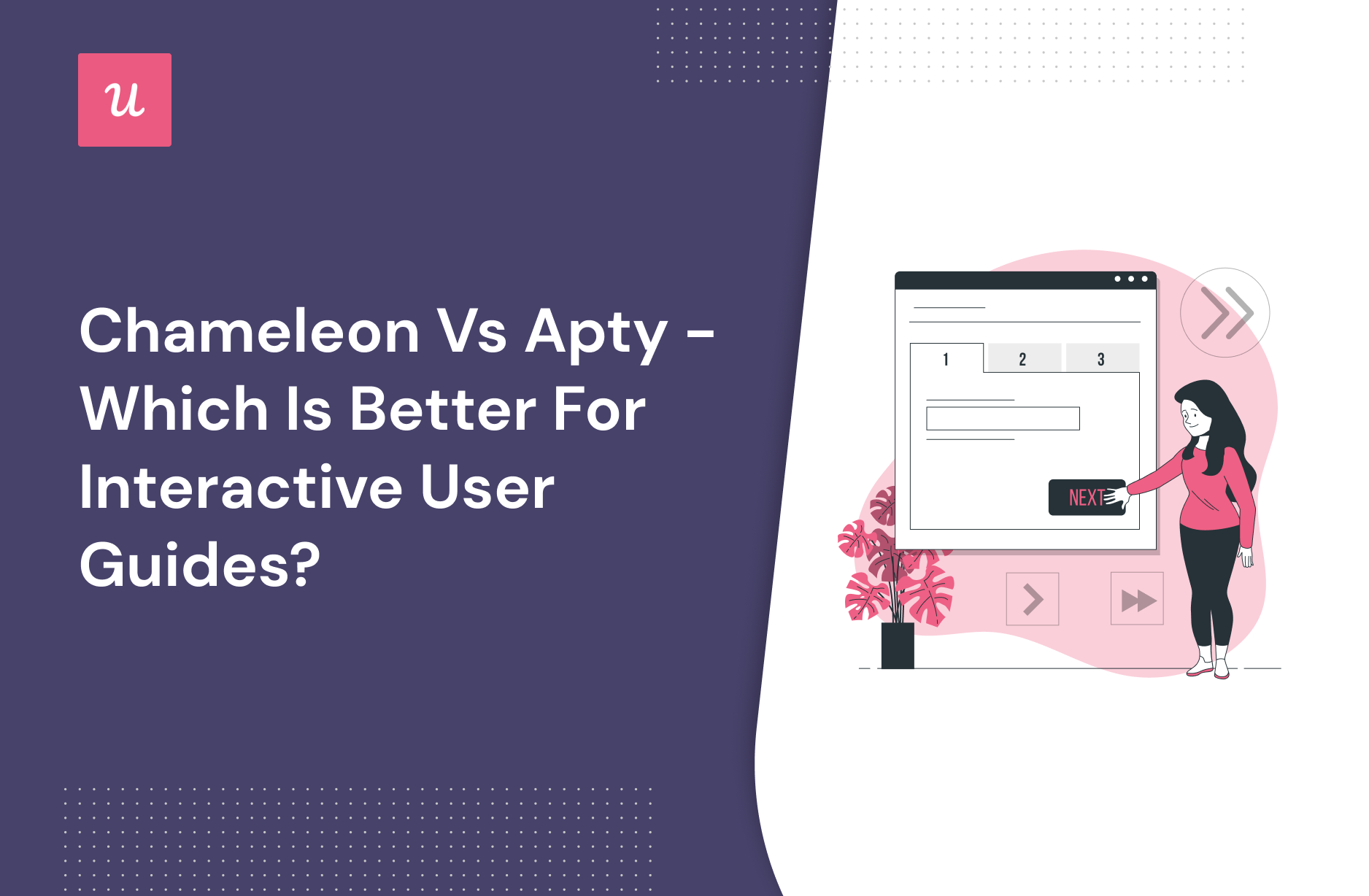
Which is the ideal tool for interactive user guides; Chameleon or Apty? Or is there an in-app onboarding software superior to the two?
With so many tools available on review sites, finding a software that suits your requirements and budget can be overwhelming.
This article examines the necessary features for the perfect interactive user guide tool and helps you select the best fit for your company’s needs and budget.
Let’s get started.
TL;DR
- Interactive user guides utilize various UI patterns to educate customers on how to effectively use your product. These guides are classified into two categories: full product tours (detailed walkthroughs) and interactive manuals (in-app guidance that provides contextual help).
- By creating interactive user guides, you can enjoy numerous benefits, including quicker time to value, increased product adoption, and reduced customer success and support costs.
- Using a tool specifically designed for interactive user guides is essential as it reduces the need for developer input and allows you to trigger user guides contextually.
- A good tool should be completely no-code, provide a variety of UX patterns, offer user segmentation options, and enable you to track product analytics.
- Chameleon is a digital adoption platform that provides step-by-step guide creation, as well as the ability to launch microsurveys to collect customer feedback.
- Chameleon offers advanced segmentation features and integrates with HubSpot, Segment, Mixpanel, and other platforms. However, it is not entirely no-code, and some developer involvement may be necessary.
- Apty lets you create positive employee onboarding experiences. It makes it easy to develop in-app guides for your new starters and trigger contextual guidance to different employee segments.
- On the contrary, Apty lacks important UI patterns and feedback collection. Also, it can’t be used for customer onboarding.
- Userpilot is a superior alternative to Chameleon and Apty. It is a robust product adoption platform that offers impressive UX patterns, in-app checklists, interactive walkthroughs, and in-app resource centers, among other features.
- With Userpilot, you can expect great value for your money, as it is cost-effective and quick to set up. However, it is not suitable for mobile applications and cannot be utilized for employee onboarding.
- If you are interested in what Userpilot offers, book a demo today.
![]()
Looking for the best tool for interactive user guides? Search no more!

What is interactive user guides?
An interactive user guide is a set of UI patterns designed to work together and help customers understand how to use your product.
There are two main types of user guides: full product tours (which tend to be more detailed and time-consuming), and interactive manuals (using tooltips and real-time guidance to provide more contextual help to your customers).
Interactive user manuals are an excellent way of engaging and educating your users, helping them to get the most out of your product, and improving user onboarding and feature adoption.
Why should you care about interactive user guides?
All product managers want to delight and engage their customers. A big part of that is making sure your users know how to get the most from your application (and in the modern world, that means more than creating a support documentation page).
Fail in that mission, and you risk damaging customer loyalty. Here’s why building interactive user guides is important:
- Interactive user guides improve user onboarding and drive product adoption. How? By helping real users get value from your product through engaging with interactive content relevant to them.
- Contextual and personalized interactive guides will shorten the time to value and reduce friction in the adoption of your product.
- In-app guides are part of a self-serve onboarding strategy and they reduce support and customer success cost while increasing customer satisfaction. Users just get access to help, when they need it.
All in all, interactive user guides are the backbone of a successful onboarding strategy and should be a must for your user experience,
Why do you need tools for building interactive user guides?
Wondering why you even need a tool to create interactive user guides? There are several reasons why you may need one:
For most software companies, creating interactive manuals from scratch is the wrong approach. Why?
Rather than reinventing the wheel, your developers should prioritize their efforts around enhancing your software – making it faster or more visually appealing – and regularly shipping updates that delight your customers.
Here’s how using a tool can help:
- With the low technical barrier to entry, anyone – from operations to customer success managers – can quickly create an interactive tour, which means you can reduce reliance on software developers.
- Rather than a “one size fits all” approach, you can trigger user guides contextually – so based on the specific actions the customer has taken, targeted support is triggered to help them navigate and use the product more effectively.
- There are dozens of variables you might want to adjust, from small changes to copy to tweaking the design. In a custom-built tool, this represents a significant amount of work – in a no-code tool, it’s incredibly simple.
- Customer adoption tools make it easy to see which version of an interactive user guide performs more effectively with A/B testing (and adapt your approach accordingly).
You shouldn’t question the necessity for a tool to build interactive user guides, but you need to understand what functionality you should look for in a tool and which tools are the best.
Must-have features for building no-code interactive user guides?
Not all tools are built the same. Some offer different advantages over others while some will simply get you basic functionality but at a low price. It depends on your budget and needs which will be the best tool to build interactive user guides.
Here’s what to look for as the main functionalities when picking a tool to build in-app guides:
- Good range of UI patterns to use for building your guides.
- Ability to customize each interactive guide to fit your brand and style.
- Segmentation so you could trigger the guides to the right audience at the right time. A one-size-fits-all approach won’t bring you the desired results.
- The ability to trigger the user guides when specific in-app events happen is nice to have and will help you build more contextual in-app experiences.
- Minimum product usage analytics, to be able to track how users engage with the product, and where they get stuck so you can build relevant user guides to help them.
The above list is not exhaustive but it’s a starting point. Depending on your product, you might also need automated localization, A/B testing capabilities, advanced analytics or security, and more.
Chameleon for interactive user guides
Chameleon is a digital adoption platform with a difference: while the other tools discussed are mostly no-code, Chameleon will require some developer involvement.
Nevertheless, it’s a powerful and effective tool that works in a similar way to Userpilot and offers similar features: styling, analytics, templates, goals, A/B testing, and checklists.
However, it doesn’t offer a resource center, or dedicated NPS, and it’s a lot worse value for money with limited features in the basic plan, which is $100 more expensive for the same number of MAUs.
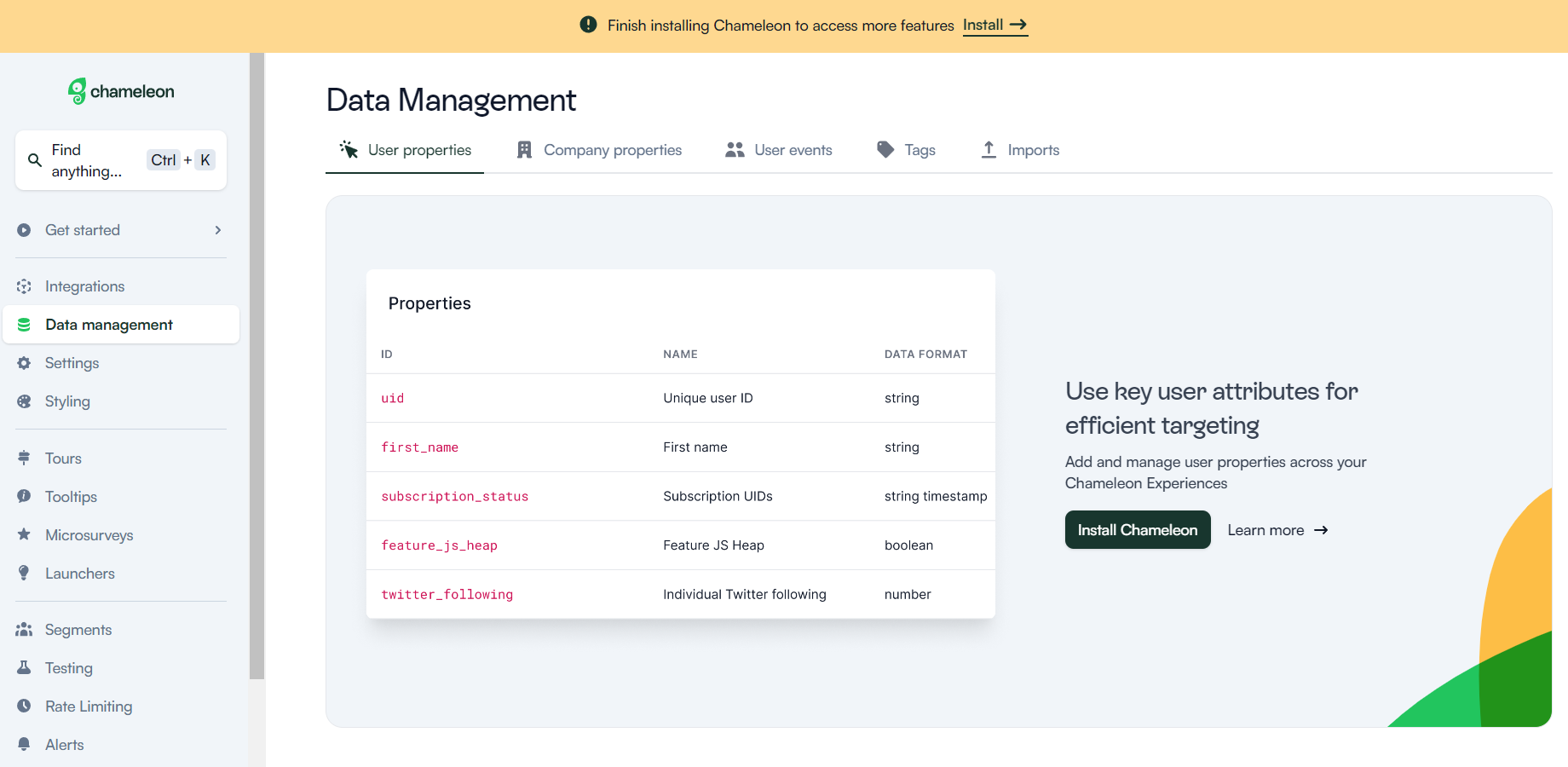
Chameleon is a no-code solution for SaaS product adoption. It offers four key products:
-
Step-by-step tours: to guide users through the product
-
Self-serve launchers: for easy access to resources
-
Tips: for unblocking users and giving best practices
-
In-product microsurveys: for gathering contextual feedback
By allowing you to personalize customer experiences, you’re able to create user flows that will lead to the successful adoption of your products.
Additionally, Chameleon offers highly customizable styling, allowing you to create experiences that look native rather than like external products.
Pros of Chameleon?
Chameleon is a robust tool for your onboarding and adoption needs. Here are the main pros to consider if you’re still deciding:
- Offers a good range of in-app messaging and UI patterns. You can create custom modals, slideouts, tooltips, hotspots, launchers (checklists or resource hubs), and more.
- Good segmentation options, you can either build different user segments inside the product, or you can integrate your Chameleon account with other tools and import your data.
- Can be used on 3rd party tools, meaning you can use it for employee onboarding too.
- Offers a good range of two-way integrations: Mixpanel, Segment, Intercom, Customer.io, Segment, HubSpot, etc.
Cons of Chameleon?
While Chameleon is a great tool, the main downside is the cost and restrictions you get with it. Here are the main cons of the tool:
- There are some limitations to user onboarding flows. You can’t run multiple in-app experiences at the same time, as you can in Userpilot. Instead, Chameleon enables you to create user onboarding campaigns (different sequences of product tours shown over time).
- It’s built for single-page apps: Chameleon can’t build flows that run over multiple URLs.
- Doesn’t offer a self-service resource center where users can access multiple guides and tutorials or contact support. It does provide launchers that are similar but more restricted. A launcher can be a checklist or a list of resources, but can’t be both.
- It has a steeper learning curve and it’s not a completely no-code tool.
- The Startup (starter) plan is quite restrictive and expensive (starts at $349/mo for 2500 MAU and includes 1 Launcher only and 5 micro surveys). You will need to go for Growth ($1249/mo) if you want to drive product adoption.
What users say about Chameleon?
Users appreciate Chameleon’s versatile functionalities. Let’s see what they have to say about it.
I love the variety of formats we can build in Chameleon, from interactive tooltips to progressive tours and launchers! It’s also really easy to track performance of each of these and adjust accordingly. The interface still feels quite clunky whenever I’m in build mode. For instance, I don’t like that I have to use markdown and CSS when formatting text instead of having an inline styling menu to select from. Then there’s also the issue of surveys or tour steps appearing where they’re not supposed to, apparently mistaking an element in another page for the anchor. -Nikki D
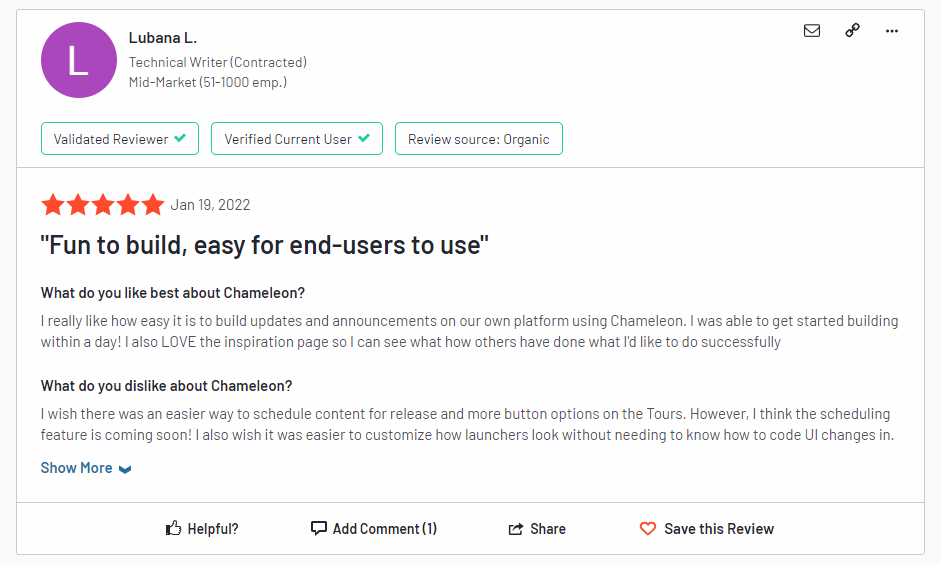
Chameleon is a good tool overall and it’s loved by its users. Most complaints are about the price and some limitations such as customization of tours and reporting and analytics.
I wish there was an easier way to schedule content for release and more button options on the Tours. However, I think the scheduling feature is coming soon! I also wish it was easier to customize how launchers look without needing to know how to code UI changes in. – Lubana L.
There is limited reporting and dashboarding functionality within Chameleon currently. – Administrator in Financial Services
I think the software is a bit on the pricey side, but since it lets us do things that we would normally need our developers to do, we are truly saving in the grand scheme of things. It means we can focus on features and bug fixes, instead of building a new communication method that would only be used internally!-Nathalie L.
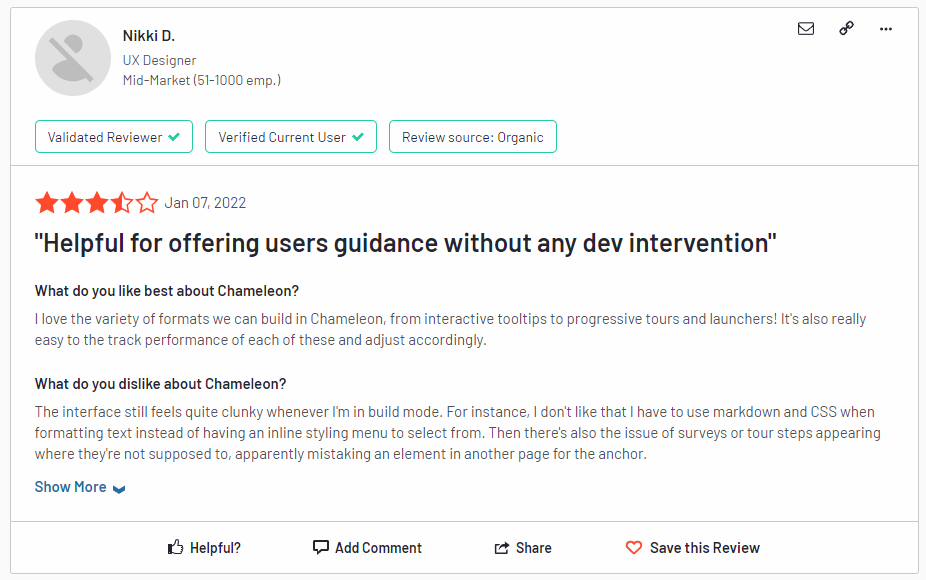
Is Chameleon the right fit for your business?
Chameleon is a great tool but we can’t say it’s the best there is. Here are three main reasons why you might consider an alternative.
- To get access to all the needed tools for proper onboarding and adoption you need to pay for the higher plans that can get expensive.
- Chameleon focuses on customization but in most cases, you will need a lot of CSS to achieve the look and feel of your brand. There are other tools that are truly no-code.
- If you need proper product and user analytics without having to pay for extra tools and integrate with Chameleon, you might need to consider a different tool.
Chameleon pricing
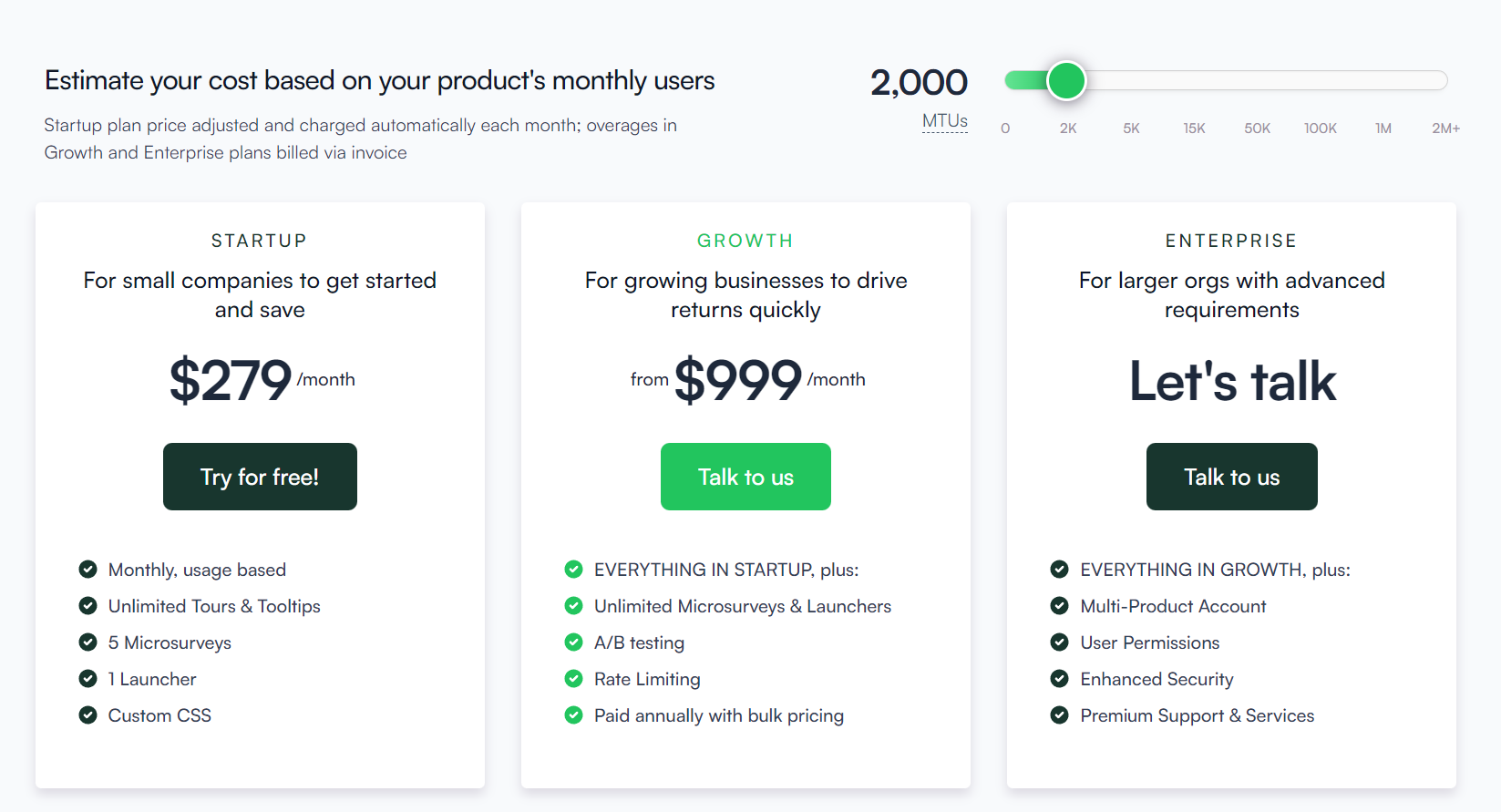
Chameleon split their pricing options primarily by the number of monthly active users, but you should keep in mind that the Startup plan also has limited features and might not be enough for interactive user onboarding and adoption for SaaS products:
- 0 – 2500 MAUs: Startup plan from $349/mo, Growth plan from $1249/mo
- 2000 – 3000MAUs: Startup plan from $419/mo, Growth from $1299/mo.
- 3000 – 5000 MAUs: Startup plan from $489/mo, Growth from $1449/mo.
- 5000 – 10,000 MAUs: Startup plan from $629/mo, Growth from $1749/mo
Disclaimer: with the Startup plan you only get 5 microsurveys and 1 launcher, no A/B testing, no Goals, and no localization.
![]()
There is a better tool for your SaaS than Chameleon!

Apty for interactive user guides
Apty’s digital adoption platform aims to make employee adoption a snap with engaging onboarding flows and product tours. It does this with a mix of on-screen guidance, interactive walkthroughs, and in-app messaging.
This platform is great for engaging your employees on your platform to increase product adoption, feature adoption, and improve the experience.
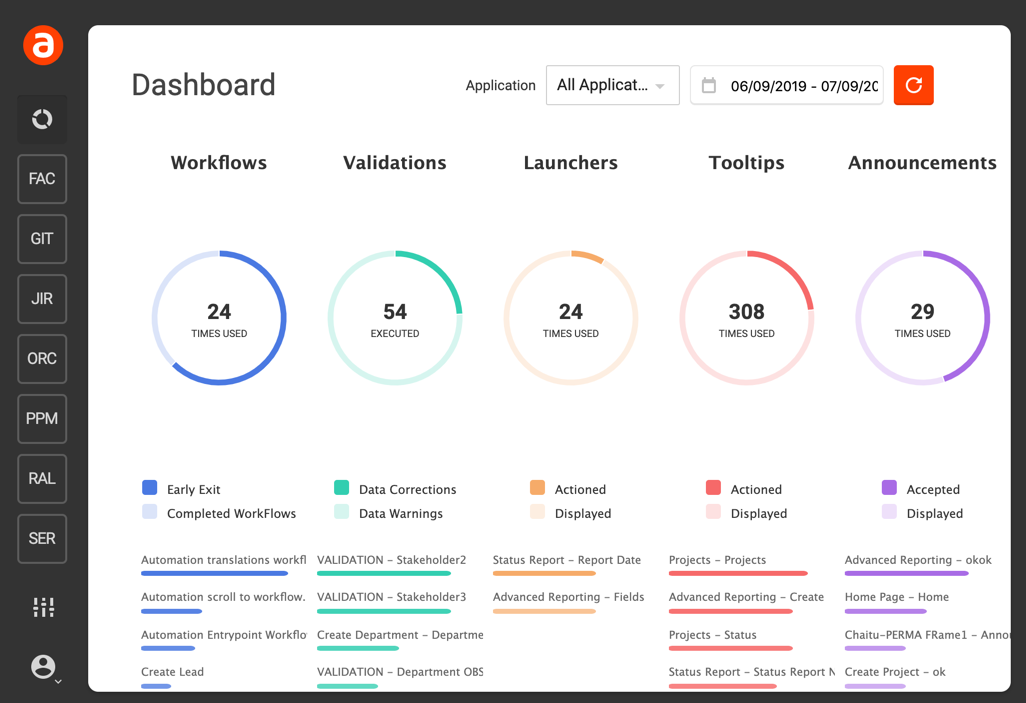
Here’s how Apty can help with employee product adoption:
- Apty allows you to create interactive walkthroughs, onboarding flows, and product tours to help new employees discover new features and adopt your platform.
- It lets you segment your users by feature usage and then targets the experiences only to the ones that haven’t adopted a certain area of your product yet.
- Apty allows you to use tooltips to engage users directly in-app.
Pros of Apty?
Apty is a robust tool for your employee onboarding and adoption needs. Here are the main pros to consider if you’re still deciding:
- Apty is excellent for employee adoption, training, and onboarding. The tool makes it easy to develop in-app guidance for your new starters.
- You can either build different user segments inside the product, or you can integrate your Apty account with other tools and import your data.
Cons of Apty?
While Apty is a great tool, the main downsides are the cost and restrictions you get with it. Here are the main cons of the tool:
- Apty offers tooltips and checklists for building product experience flows, but unlike other similar tools, it lacks some important UI patterns such as modals, hotspots, banners, and slideouts.
- One of the biggest disadvantages of Apty is the absence of in-app customer feedback collection. You are kind of limited to embedding surveys built using other tools.
- Doesn’t offer self-service support like a help center where users can access multiple guides and tutorials or contact support. It does provide guides that are similar but more restricted.
What users say about Apty?
Overall, users feel positive about Apty – here’s an example summarizing some key points about its features and the value it offers:
Our Apty Representative, Joe Fimiani, is one of the main reasons we love working with Apty. Joe works hard to establish a trusting relationship with his customers. Joe goes above and beyond to ensure we are satisfied and happy with our Apty product by doing regular check-ins.One thing that is a little frustrating is getting past the Apty pop-up widgets. Sometimes the pop-up widgets are in the way of tabs that need to be selected. As a result, the tabs are harder to select. However, this may not be an Apty issue, rather a Clarity issue 🙂 –
Desiree G.
Apty is incredibly helpful for new employees to get familiar with processes in our project management software. The work flows and tooltips have been essential for our workforce.The only downside to Apty was the learning curve of first building out the application to work with our project management tool. Apty had a great support system to help through those challenges. – Jennifer T
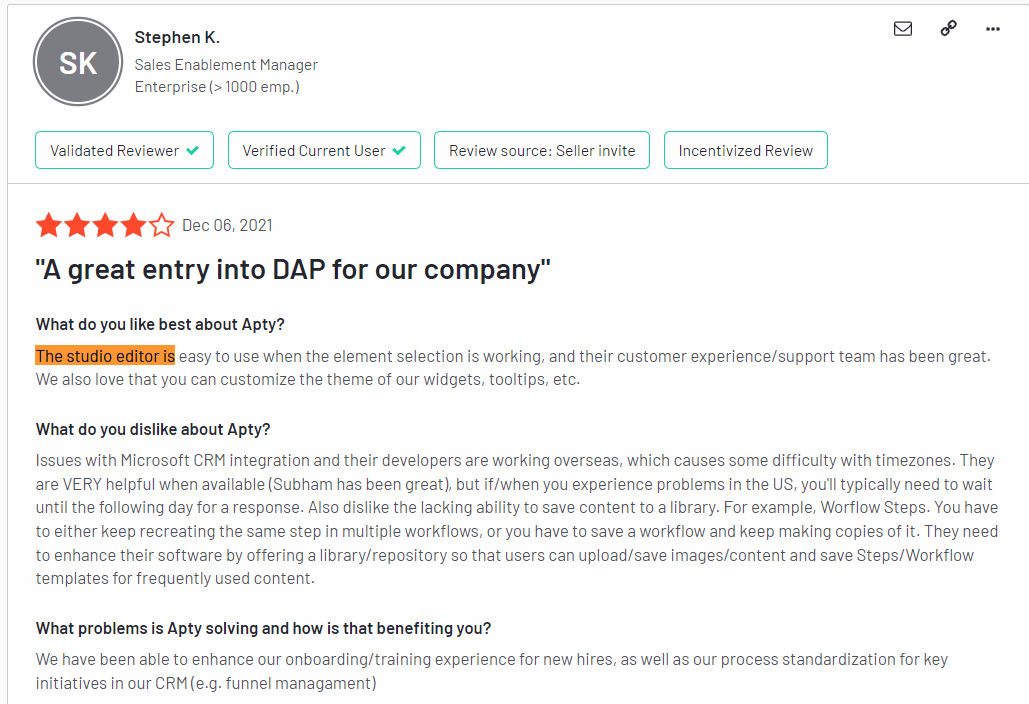
Most complaints are about the missing features, integrations, and the steep learning curve.
It’s tricky to make the most of it, particularly in the early stages of adoption. The support team are great, but it can be challenging to know what support can be asked for if we’re unaware of what’s possible.- Administrator in Business Supplies and Equipment
With each new release of the software, there is a bit of uncertainty in the stability of new features. Requires more attention than preferable with each new switch. Also, our tools are more complex than your standard website and that requires more work and work-arounds than expected when first acquiring a third-party onboarding tool.- Administrator in Computer Software
UX experience when it comes to testing is cumbersome; a lot of back and forth.
Below are critical tools that are missing or need improvement. I would like to see these additions and enhancements as current features are limiting our options for solutions: Auto triggers (Related to Rule Engine, i.e. Specific page load, removing the reliance on triggers such as: Launchers, Menu Widget, and Announcement Button),IDP for standardized User Identifier,eLearning for content creators (Builder Certifications),Surveys,Chatbot etc- Paolo T.
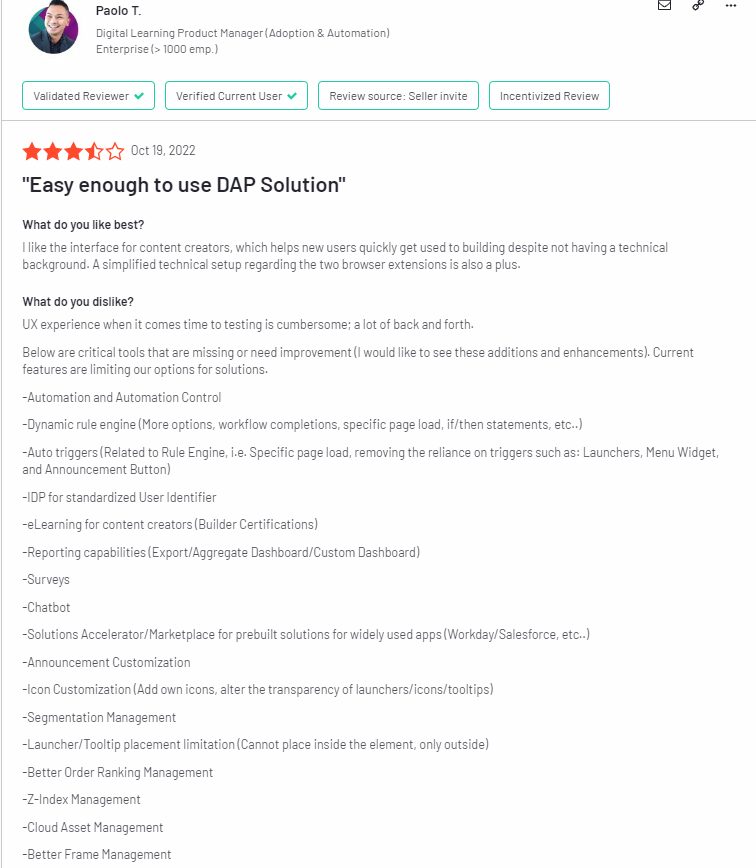
Is Apty the right fit for your business?
Apty is a great tool that accelerates the adoption of technologies into employees’ daily workflows. However, it has limited usability. Here are three main reasons why you might consider an alternative:
- To get access to all the needed tools for proper onboarding and adoption you need to pay for the higher plans that can get quite expensive.
- Apty doesn’t offer user feedback surveys, which are a very effective way to collect user sentiment at scale and improve employee onboarding. So if you are aiming to be more user-centric, you may need to choose another tool.
- Although Apty offers some segmentation options for more personalized training, in Userpilot you can group users on many more attributes and create more advanced segments.
Apty pricing
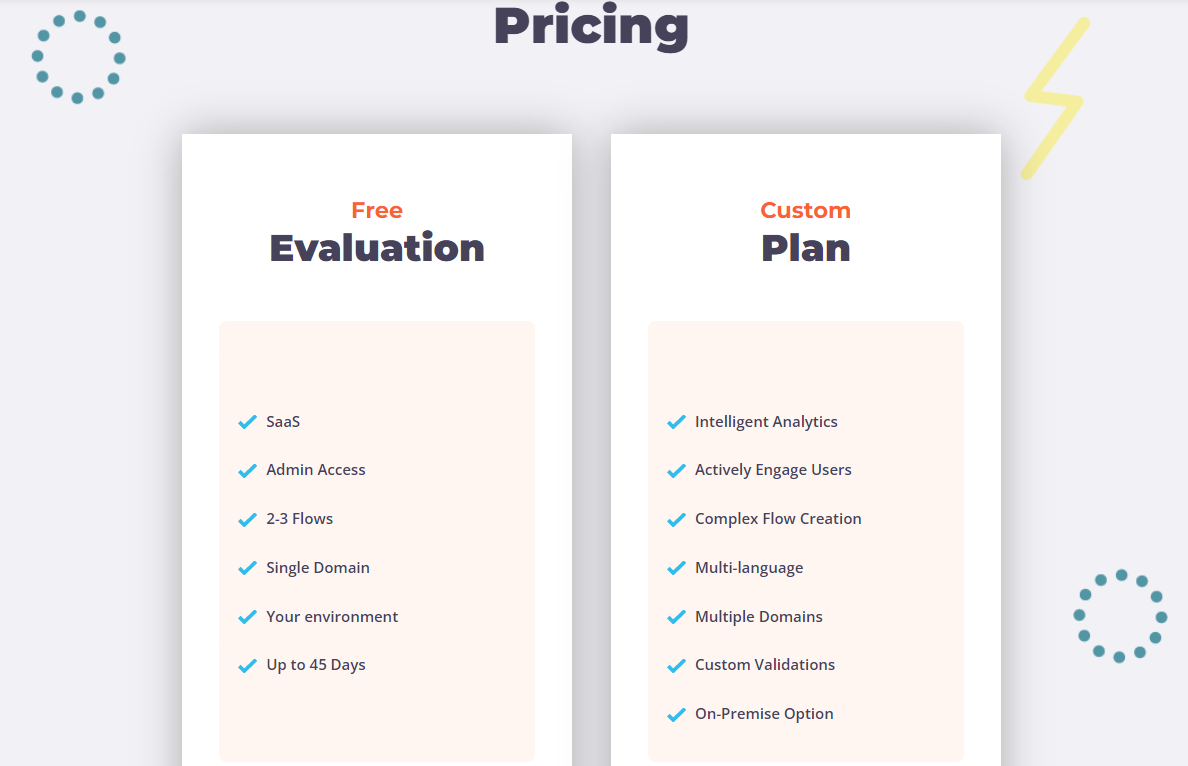
Apty offers a free trial and custom quotes based on business needs.
- Free trial: Up to 45 days, includes 2-3 flows, works on a single domain.
- Custom pricing: Intelligent analytics, complex flow creation, multilingual support, available on multiple domains.
![]()
There is a better tool for your SaaS than Apty!

Is there a better alternative for interactive user guides?
Chameleon and Apty are good tools for interactive user guides. We’ve seen how they compare to each other and what you can achieve with them. Call us biased, but if you’re looking for something better, Userpilot offers more value for your money than these tools.
Userpilot for interactive user guides
Userpilot is a powerful product adoption platform that enables you to quickly build personalized, flexible, contextually relevant in-app experiences targeted to different user segments – all without writing a line of code.

Product adoption describes the process of getting users to the point where they are experiencing value from your product.
Userpilot is a powerful product adoption platform that enables you to quickly build personalized and contextual in-app experiences targeted to different user experiences – all without writing a line of code.
It’s a great option for enterprise users too since it’s SOC 2 Type II certified and offers robust features for large-scale usage.
Here are some of Userpilot’s product adoption features that you may find helpful:
- A broad range of UI patterns to build fully customizable, contextual, and interactive in-app flows: modals, slideouts, tooltips, hotspots, driven actions, banners, and more. And – most importantly – you are not limited by plan when it comes to how many UI patterns or designs you can build.
- Advanced in-app checklists with built-in gamification elements like progress bars or ”automatically marked complete” tasks: checklists also come with analytics so you can track who is interacting with them and how.
- Fully interactive walkthroughs walk users through engaging and adopting specific features of your app.
- The self-service in-app resource center lets users search your knowledge base directly inside the app, access chat, and support but also launch guides and tutorials when they get stuck.
- User feedback tools allow you to collect insights to improve the product and the user experience, thus leading to a higher product adoption rate. You can also collect NPS data and tag responses to uncover patterns into what makes users stick, or build micro surveys for more granular data. Then you can use all the feedback collected to build user segments based on the answers and personalize the path to higher product adoption for each segment.
Want to see Userpilot in action? Get a demo and improve product adoption with contextual and personalized in-app flows that actually help users.
Pros of Userpilot?
Userpilot has a number of advantages, especially for mid-market SaaS companies looking for a robust but at the same time very easy-to-use, no-code tool for user onboarding, product adoption, and simplified product analytics. Let’s have a look at the pros of using Userpilot:
- No-code builder – Userpilot comes with an easy-to-use Chrome Extension builder.
- Multiple UI patterns – choose from a range of options to build customized flows: modals, slideouts, banners, tooltips, hotspots, and checklists are all at your disposal.
- UI patterns are not limited by plan – you get access to all of them on every single plan, meaning you get value even with the Traction plan (this is the entry-level one).
- Engaging walkthroughs and onboarding flows- build interactive walkthroughs targeted to distinct user segments.
- In-app help – build a resource center offering self-service support to your users, customize it with your branding, and select from a range of help options to boost user satisfaction (i.e., videos, in-app flows, chat, and more).
- Experimentation – built-in A/B testing for flows lets you explore and quickly iterate based on direct user behavior.
- Powerful feedback options- integrated NPS surveys with analytics and response tagging unlock insight into how your users feel.
- Advanced analytics and segmentation – analyze product usage and in-app flow engagement and build user segments using the data.
- Event tracking and feature tags – tag UI engagement (clicks, form fills, hovers) and group them into one custom event to track what really matters.
- More value with integrations – unlock value faster with built-in integrations with popular tools like Segment, Amplitude, Mixpanel, Kissmetrics, Intercom, Heap, and more.
Cons of Userpilot?
There are, however, some downsides to Userpilot as well:
- Browser/web app only – Userpilot won’t run on mobile devices/applications.
- Doesn’t support employee onboarding. The tool is better suited for customer onboarding than for employee onboarding as you can’t build in-app guides on third-party tools.
- Missing integrations – doesn’t have built-in integrations with some tools, but it has webhooks, and HubSpot and Zapier are coming soon.
- Not appropriate for small startups on a shoestring budget (<$100) – Userpilot is a powerful, mid-market to enterprise-level tool. So $249 a month might be too expensive for really small startups.
What users say about Userpilot?

Let’s check what real users like about Userpilot.
Userpilot is an incredible, user-friendly software that allows us to create unforgettable experiences for our clients! From basic to complex experiences, we have been able to do them all with ease! I would highly recommend this software to anyone who wants to provide their clients or users with the best product tour experience. The possibilities of what you can create are endless! – Tayla G.
Userpilot is simple to set up, use, and does not require any dev – which means instant publishing. This is critical for us as a SaaS company that releases new features frequently; we need the ability to inform our customers of changes quickly, and doing this in our platform through Userpilot allows us to reach the right audience, at the right time, in the right place. There have been many awesome extra features we’ve discovered since coming on board, and it’s been great to see new features released frequently. The tool itself is intuitive and reliable. Having used similar products previously that were clunky and buggy this has really made us happy with our decision to move to Userpilot. – Melina K.
![]()
Get more value for your money with Userpilot!

Userpilot pricing
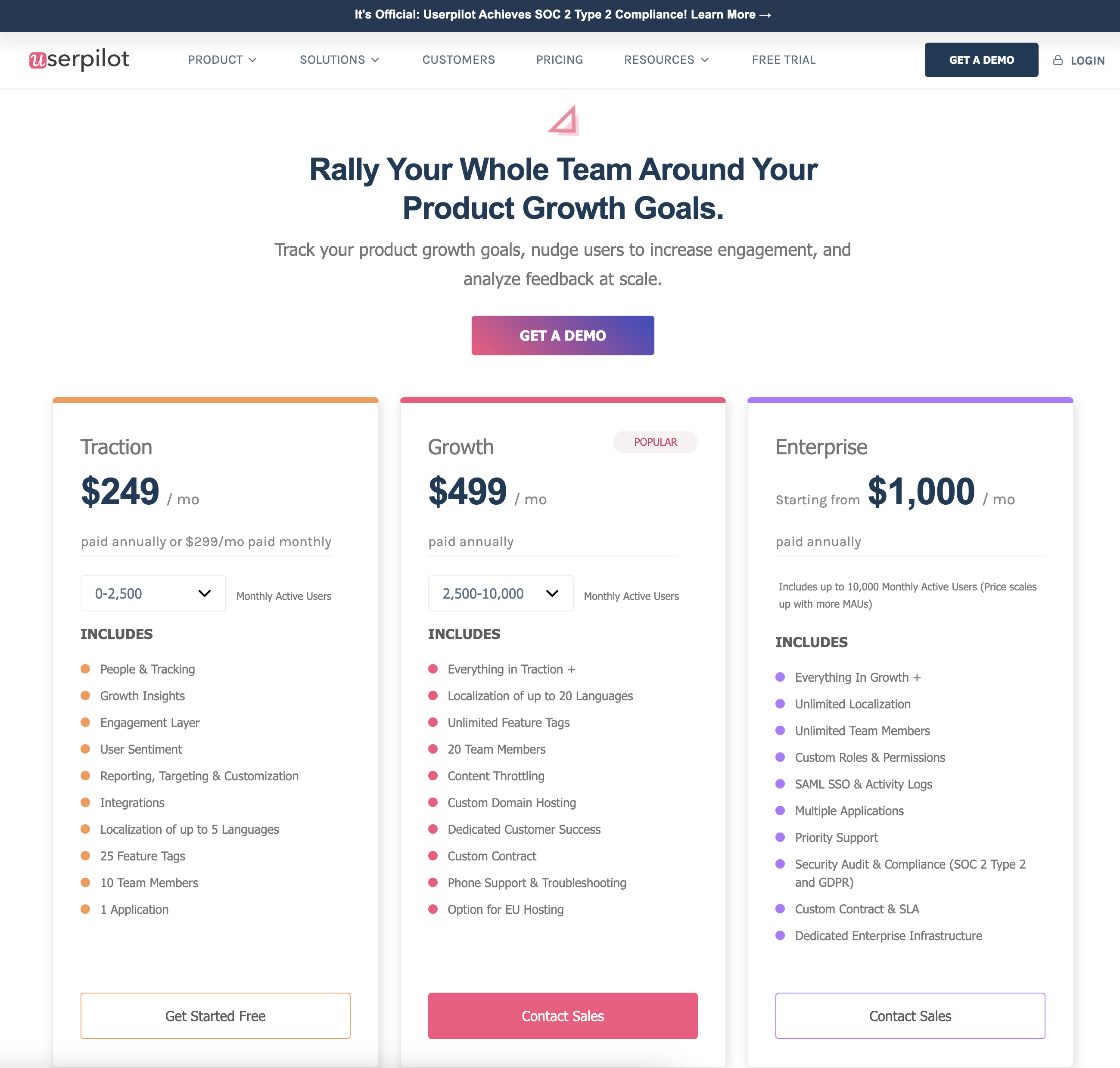
Userpilot offers great value for money compared to other similar tools on the market. Even its entry-level plan (Traction) provides all the necessary features without any usage limit.
The price-to-feature ratio is the best for Userpilot. Other cheaper tools in the market would definitely not fulfill your needs, and others like Pendo would be out of budget. Userpilot sits in that sweet spot. – Saurav S.
The pricing differentiation happens mostly on the service level (e.g., custom domain hosting, dedicated Customer Success Manager, SLA) and is based on the number of Monthly Active Users (MAUs) your company has.
Here’s the detailed Userpilot pricing:
- Traction: For up to 2500 users, this plan is $249/ mo.
- Growth: For up to 10,000 users, this plan is $499/ mo.
- Enterprise: For large-scale businesses, these plans begin from $1,000/ mo.
Conclusion
Deciding between Chameleon and Apty should now be a simple task. Although both tools have their own sets of pros and cons, there is no definitive “best” option, as it ultimately depends on your product and current requirements. Our recommendation would be to consider the alternative option if you are looking for the best value for your money.
If you are interested in exploring how Userpilot can assist with interactive user guides, book a demo now.
![]()
There is no better tool for your SaaS than Userpilot!


